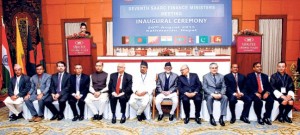SAARC Development Bank averted

The seventh meeting of finance ministers from member countries of the South Asia Association of Regional Cooperation (SAARC) has turned down the Indian proposal to established SAARC Development Bank anytime soon.
The plan to form SAARC Development Bank was floated in the 18th SAARC Summit held in Kathmandu. But the idea has been deferred taking into account the formation of regional infrastructure banks like Asian Infrastructure Investment Bank and BRICS Development Bank.
Rather the member countries have agreed to extend assistance in economic and infrastructure sector of member countries by mobilizing SAARC Development Fund (SDF). The funding was limited to social sector so far.
They also decided to appoint a fund manager to collect funds and conduct credit rating for USD350 million SDF.
An experts’ group will devise necessary strategies within six months to address the need for fund for non-infrastructure economic projects and infrastructure projects. If required, branch offices of Thimpu-based SDF will be extended.
The meeting also revised the charter of SDF. Now onwards, member countries have their own projects. Earlier only the projects of common importance run simultaneously by at least three member countries were qualified for the grant.
The region which lags behind in infrastructure development front and connectivity for economic and financial integration will utilise the fund primarily for projects in areas such as energy, power, transportation, telecommunications, environment, and tourism, among others.
Removing non-tariff barriers as well as trimming the sensitive list to boost intra-regional trade were the other issues discussed in the meeting.
